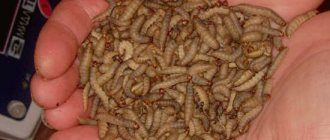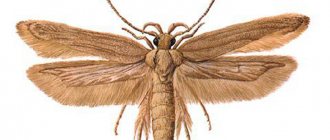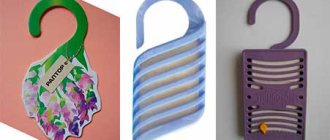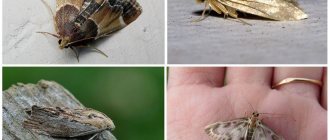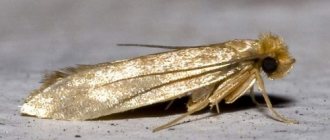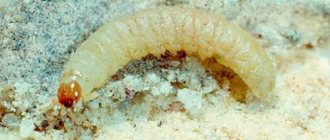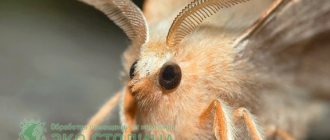A fur coat is the warmest and most expensive item in any wardrobe. Clothing made from luxurious fur is bought for more than one year, so it is so important that it retains its appearance for a long time.
The main problem that owners of such things may encounter is moths, or rather, their larvae that are deposited. What does a mink coat look like that has been eaten by larvae, and how to get rid of it and protect yourself with moth repellents, you will find useful recommendations from specialists.
When infested by pests, characteristic bald patches appear. Using effective products and proper storage methods will help get rid of harmful butterflies and prevent their appearance.
How to tell if a moth has eaten your fur coat
Food butterflies and other species often appear in the apartment. Clothes or fur coat varieties are harmful. To take the necessary measures, it is important to know what a fur coat moth looks like. It looks like a light and colorless individual of small size. It is difficult to identify and recognize, it is practically invisible, and is located deep in the pile, in a deep bag. After it, bald spots appear.
Butterflies may vary slightly in size and color, but caterpillars are similar to each other. You can see what a fur coat damaged by moths looks like in the photo.
You need to know the enemy by sight
There are different types of moths: there are about 40 species of this insect. However, the most common ones that can find a place in our houses and apartments are furniture, grain, clothes and... fur coats! Yes, from its name it is immediately clear which of them is the thunderstorm of fur products.
So, it is worth urgently taking measures to save your fur wardrobe if a small moth with a wingspan of about 1.5 cm, clay-yellow in color, and with lower wings of a light gray color with a yellowish tint, suddenly flutters out of the closet to “get some air.” The caterpillars of this moth resemble white worms with a brown head.
By the way, the moth caterpillar is insidious because it gnaws all fur fibers in its path, regardless of whether it eats them or not.
By the way, the “relative” of the fur eater is the clothes moth. But it is larger than the fur wing - 20-22 mm in span and slightly different in color: the front wings are violet-brown at the base, and light yellow from the middle. This is provided that you decide to consider who exactly has settled in your closet, and do not reflexively slam the uninvited guest.
Fur coat damaged by moths
Adults hide in the folds of a mink or mouton coat and piles of things, where they prepare for reproduction.
In inconspicuous corners, harmful butterflies lay eggs, from which caterpillars emerge. The fast-growing caterpillars begin to eat textiles and leave marks.
The presence of moths is indicated by the following signs:
- It looks like it’s not combed, but rather ragged. The fibers stick out in different directions, and the surface looks sloppy.
- There are hairs in the places where the headset is placed after moths have started to appear and the caterpillars have begun to eat the lint.
- Tracks appear on the surface as the caterpillars move.
What to do if a moth has eaten a mink coat?
Many women, seeing an unpleasant “surprise” for themselves, panic, get upset, mentally throw away the damaged product and make plans to beg their husband for a new mink coat. But if you love a product very much, you don’t want to give it up. You can avoid further eating of your fur coat by moths. We offer some tips for eliminating unwanted guests.
- To begin, take your fur garment outside. Shake it well. Such manipulations will save you from existing insects. In addition to mechanical impact, temperature shock also helps. These individuals are afraid of high and low temperatures. If the moth appears in the summer, the heat and sunlight will kill the existing larvae. It also fights moths and frost in winter.
- A good addition to the previous actions would be to comb out the eaters. But since it is difficult to destroy the larvae with a regular accessory, use a fine-toothed comb. But you need to do this exclusively on something, so that you can easily destroy the pests later.
- In difficult cases, insecticidal agents are used. Today, there are various chemicals that will help cope if moths start eating fur coats. An aerosol with an insecticidal spray is used to treat the fur coat and the closet where it was located. Afterwards, the fur product is wrapped in a cover. Clothes should be sprayed periodically every 2-3 weeks.
Also read: Causes of potato moth
To prevent the appearance of moths in your wardrobe, you need to carry out prevention. Check out the video that will help you carry out all the activities correctly.
Where do larvae come from?
The main sign of pests is flying through the cabinets and throughout the apartment. Defects can only be detected when worn, when tears can form in damaged areas and fabrics can unravel.
Before purchasing, a fur coat should be examined for the presence of fine traces of lint. When you arrive home, you need to hang your purchase on the balcony. Ventilate items only in warm weather. It could be a warm sunny day or even a winter frost.
The sun and air drive out possible insects.
Many people are interested in where moths come from? Items brought into the house must be inspected for the presence of parasites. The insect enters the house already on objects purchased in stores, in the form of invisible larvae, or even on the fur of dogs or cats. Pests that get into the house begin to eat fabric and other objects.
Actions to take if a fur product is contaminated
A product can become infected during storage in the warm season or if there are larvae in the closet or room where it is stored.
Signs of infection
The signs are easy to spot, as they are immediately obvious. This:
- A fur coat affected by moths loses its attractive appearance and lumps form on the surface.
- The folds and wrinkles that form are paths cut by the larvae.
- Trimmed fur pile.
- Formed bald patches on the surface.
- Presence of butterflies in the room where the product is located.
If you notice one or more of these signs, it is important to take action.
How to save a product
There are several ways to save a fur coat damaged by moths. If the situation is not critical:
- You can tint your bald spots to match the color of your fur.
- A small “bald spot” can be cut out, and the edges from the inside can be sewn together again.
- A spot in the chest or collar area can be decorated with a brooch.
- In some situations, you can shorten the product or cut off the sleeves and make a fur vest.
How to quickly kill insects
Raptor from moths.
Fur owners need to know what to do if moths have already appeared. It is necessary to destroy the larvae as quickly as possible. For this purpose, anti-moth products for fur coats are suitable, which can destroy insects in a matter of hours.
After treating your fur coat with insecticidal agents, you need to put it in a plastic bag for several days. You can use dry cleaning services, where the product will be processed at high temperatures.
Insecticides and aerosols are effective. In special stores you can choose for every taste and budget. Raptor extramit, Armol, Clean House have proven themselves well.
Effective means
There are many chemicals and folk methods on how to preserve mink fur and get rid of moths.
Case
You can use the raptor case. The sealed clasp will protect against pests getting inside. In this case, insects that get inside die. The special composition does not harm objects and does not impregnate them with foreign odors. Similar raptor products can be seen in the photo.
Aerosol
Do not spray the product directly onto the surface. This can ruin the fur. In this case, the entire cabinet is treated against moths. One can will be required for the entire season. The procedure is carried out twice a month.
Since the products contain insecticidal components that are harmful to humans, a mask, respirator and gloves are worn.
Children and animals should be removed from the room, as fumes can cause poisoning. After processing, the cabinets are tightly closed.
Such drugs as raptor, aerosol raid, extra mit are distinguished by their effectiveness.
Pills
Such products are produced in special boxes. They are highly concentrated and the smell remains for a long time. The effect of the drug lasts for several months.
The tablet not only destroys moths, but also prevents them from multiplying in the closet and protects against the appearance of eggs. Sections also work. The records are hung inside the furniture, as can be seen in the photo.
Ways to fight moths
Knowing how to protect a fur coat from moths allows you to effectively protect fur products from pests:
- Prevention and proper storage;
- Insecticidal method;
- Mechanical protection;
- Folk remedies for moths.
Prevention and proper storage
Preventive measures are the best protection for fur coats from pests. Clean items and proper storage are where you need to start to prevent pests. After all, removing insects is not easy.
Application of insecticidal preparations
To store fur products, it is advisable to use a case that is impregnated with a special insect-repellent composition. Its ability to be hermetically sealed will limit access to things, and moths will not get into the fur coat. You should not use covers made of synthetic fabric for these purposes, as they prevent the penetration of air. Things in such bags can simply disappear.
If there are moths in your fur coat, you can get rid of them using chemicals:
- Aerosols;
- Fumigators;
- Plates;
- Tablets.
Moth sprays
It is necessary to treat the cabinet with aerosols at least every two weeks. Such drugs are not harmful to health, but to avoid an allergic reaction, it is better to use a respirator. How to protect a fur coat from moths? It is enough to spray the product from all sides and place it in a special case. The following brands of aerosols are in greatest demand: Antimol, Raptor Moth Protection, Armol or Clean House.
To prevent moths from eating a fur coat, you should use tablets or plates, which are no less effective. They are made on the basis of vegetable oils, therefore they are harmless to the health of humans and pets. The advantage of this product also includes its low cost.
Gels based on vegetable oils have a good effect. They are produced in special containers that are laid out or hung in the closet. The most famous gels are Antimol and Raptor brands.
Remedies for moths
Liquid agents are also used to treat fur products against moths. They effectively destroy not only adults, but also their larvae. The duration of the drug is up to 4 months. The following brands are in demand: Foxide, Mittox, Supromit and Morimol.
The use of fumigators does not provide for the rapid destruction of moths. They are designed for a long period of insect control and are used more for preventive purposes.
Mechanical protection
Our grandmothers used this method of pest control, regularly shaking and ventilating things during the hot season. Constant disturbance causes discomfort to the moth larvae, preventing them from damaging the fur coat. The advantages of this method of protection are cost savings and ease of use. However, this method cannot completely rid the product of larvae; moreover, it requires the use of physical force.
Important! It will not be superfluous to comply with quarantine measures. After all, it is possible that things can be infected with a pest while still in the store or warehouse. Therefore, you should not rush to place the purchased new thing in the closet next to the mink coat. Any item requires treatment with heat or cold against moths (in the sun or severe frost), as a result of which the moth larvae in it will die.
Folk remedies
If a moth has started eating a fur coat, it is unlikely that it will be possible to get rid of it with just one folk remedy. Orange zest can repel the smell of adult coat moths. It will not be able to protect against larvae already living in the fur product. Therefore, it is better to use it as a preventive measure. Lavender and geranium have a similar effect. It is necessary to make fabric bags, fill them with dry twigs and put them in a case with a fur coat.
Lavender and geranium
Folk recipes
Simple and natural methods of insect control are highly effective as preventative measures that can protect and protect against moths. Naphthalene doesn't help much. Folk remedies scare away butterflies with their aroma; you can make special plates with your own hands.
You can place essential oils, orange peels, scented soaps, ammonia and herbal infusions in the closet.
Combined control methods that allow you to get rid of pests are characterized by effectiveness.
How to protect a fur coat from moths: important tips
In this difficult matter, moths are one of the main enemies of many owners of a beautiful fur coat. Greedy larvae are not interested in the cost of the product and are equally merciless and ready to feast on any natural fur. Therefore, even if you think that insect control is not for you, it’s time to think about prevention.
Nothing repels moths more than the smell of lavender.
It is very important to monitor the hygiene of your fur coat and not ignore dirty and greasy stains. It is from them that the insect begins its meal, then infecting the entire product. You can clean your fur coat at specialized fur dry cleaners or by trusting experienced housewives who actively share advice on forums. It is important to put the already cleaned product in a case and only then into the closet. As a preventive measure, you can purchase fur coat covers already soaked in moth repellent or use folk remedies.
Store fur products in special cases. It has been proven that moths are repelled by the smell of lavender, geranium, dried orange or tangerine peels, tobacco, chamomile and strawberry soap. Simply place fresh geranium leaves, orange and lavender sachets, or a cotton swab soaked in essential oil in the closet where your fur items are stored. And forget about mothballs - although this is an effective remedy, it has a heavy smell that will then follow you everywhere.
Dry orange peels will repel moths from knitted items and fur products. But all of the above remedies are powerless when moths have already infected the fur. Of course, aromatic sachets will help repel moths, but they will not get rid of eggs and larvae, from which new insects will later appear. Chemicals labeled “anti-mole” will help break this vicious circle.
Alina Assi
Fashion designer
It is necessary to air your fur coat from time to time, even if you are not wearing it. It is enough just to periodically hang the product on the balcony to give it fresh air and light and repel harmful insects. But just be careful with the open sun, the fur does not like direct sunlight.
Before you start choosing a product, shake your fur coat thoroughly - as a rule, a significant part of the eggs and larvae will fly out immediately, and after that you can move on to the preparations.
The cheapest option is products available in tablet form. They have a completely expected composition - a mixture of natural essential oils and synthetic fragrances, most often with the aroma of lavender, which prevents butterflies from laying eggs. Such tablets should be placed on the top shelves of the closet where the fur product is stored. Approximate cost – from 30 rubles.
Cotton balls soaked in lavender oil can protect against moths. A more perfect remedy is moth repellent sections that are odorless. Like tablets and plates, sections are non-contact, so they just need to be hung in a closed cabinet space and replaced when they expire. Manufacturers of moth sections guarantee ease of use of the product and the destruction of not only butterflies, but also their larvae. Approximate cost – from 50 rubles.
If oil is powerless, buy special anti-moth tablets. Finally,
you can fight moths using contact agents, that is, aerosols and repellents .
Modern formulas are not only odorless, but also safe for the product and your health. You can treat the fur coat itself after cleaning and the place where it is stored. At the same time, you should not ignore the precautions indicated on the packaging and handle the product at a distance of 20-30 cm. The approximate cost is from 100 rubles. Proper care and attention are not only the basic rules for the prevention and control of insects, but will also allow your fur product to warm and decorate you for more than one season.
Summer storage
In winter, the item is worn every day and is not threatened by dangerous residents. Here's how to protect a mink coat from moths in the summer so that the fur is not destroyed by pests. Moreover, even in summer, it can be well preserved at home if you know the rules.
Before storing outfits, they should be cleaned. The cabinet is then thoroughly washed and sprayed. Repellent drugs are placed inside.
After this, the product can be placed in a bag or in a special case. It is better to prepare a separate storage space.
The following actions are carried out with a mouton or mink coat:
- Ventilate.
- After a few days, it should be combed with a special brush.
- Buttons and hooks are fastened, and all sweets are straightened.
For storage, it is necessary to choose places that are located far away from heating equipment. The humidity in the room should not be higher than 65%.
The product is packaged in dark covers or fabric bags. You can use cellophane packaging. Hangers need to be selected according to size.
Things must be periodically removed from the case and allowed to breathe, which will help protect them from insects.
Folk remedies for moths for fur coats
Of course, using strong chemical insecticides can be problematic and risky if you or anyone in your family has allergies. Despite the relative safety of moth repellents, high concentrations of substances in the air can become irritants, especially for children and pets.
But even in this case, there is a way out - folk remedies for moths for fur coats.
Herbs
The fragrant herb is an effective folk remedy for pests. The most effective herbs include lavender, St. John's wort, wormwood, cloves, tansy, and mint. The moth cannot tolerate all these smells.
On a note! If you use pads filled with grass or put dried flowers in your wardrobe, they need to be changed every 2-3 months, as the aroma disappears and the grass no longer repels insects.
Cedar branches and dried chestnut fruits also perfectly protect wardrobes from moths, and they will have to be changed much less frequently - once every one and a half to two years. Cedar hangers will be a good solution against moths and at the same time a necessary accessory.
Citrus
We most often throw away orange peels or tangerine peels, but if a pest butterfly has been spotted in your home, put citrus waste to good use!
The crusts will be reliable helpers and will help protect your fur coat from moths. They need to be changed as they dry out - approximately every month.
Aroma oils
Don’t know how to treat a mink coat against moths before storing it, and you only have aromatic jars on hand? Use them as an insect repeller!
Lavender essential oil is another truly effective folk remedy for moths for fur coats and other clothes stored in the house. Dampen a linen napkin with oil and place it in the corner of the shelf - you will be pleased with the pleasant aroma and the absence of moths. Drop oil onto a napkin as it dries.
What to do with a fur coat eaten by moths
It is very disappointing if the fur coat is slightly damaged by moths or its edges are frayed. But even in such cases, clothes can be saved if you know how to restore the product. For example, take it to the dry cleaner.
You can update the product and give it shine at home. For this, flour, talc or starch is used. The item to be treated should be laid out on a horizontal surface and sprinkled with the selected product. Then you need to rub the pile. After dry cleaning, you just need to shake the item.
How to restore clothes?
First of all, you need to do a good cleaning. A special product is purchased for the procedure. In the fresh air, the fur coat should be treated, and then the clothes should be cleaned with a brush. In this case, you can get rid of moth larvae. It is important to remove matted fur, as larvae breed in it.
You need to clean a fur coat with a light color that looks yellowish. For this you will need mild shampoos and brushes. After wet processing, it is dried, and then the dry pile is combed with a brush.
Methods of protection against moths
In order not to wonder how to remove moths from a fur coat, it is best to apply preventive measures that will provide reliable protection for all fur and wool products. For protection you need:
- Fur coats and fur items are best stored separately from other clothing. With this precaution, clothes moths will not be able to damage the fur coat when searching for a new food source.
- For storage, use covers that are impregnated with special preparations that repel insects at any stage of development. The advantage of such cases is reliable protection even during long-term storage, since the cases are hermetically sealed. You should avoid synthetic products to prevent the item from suffocating.
- Use special aerosols that treat wardrobe items and the inside of cabinets. It should be remembered that treatment must be carried out regularly, according to the time limits indicated on the packaging of the drugs.
- A great way to prevent pests from entering your home is to quarantine new items. All clothing should be aired in the fresh air for 2-3 days, which is enough to destroy the larvae.
- Use electrically powered fumigators or natural moth repellents. Aromatic oils of wormwood, cedar, juniper and geranium have proven themselves to be excellent. They can be applied to a cotton pad and placed on shelves. A good option is canvas bags with dry geranium or wormwood leaves, but they should be replaced periodically.
You can protect your fur coat with anti-moth aerosols, which are sprayed directly onto the fur. Modern technologies have made it possible to create preparations that do not affect the appearance of clothing and perfectly repel caterpillars and adults.

